Click on images to enlarge
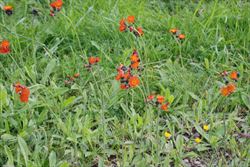
infestation (Photo: Rob and Fiona Richardson)
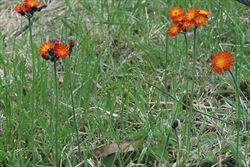
habit in flower (Photo: Rob and Fiona Richardson)
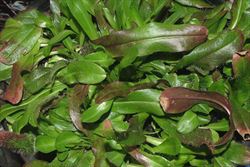
the dense mat-forming habit of this species (Photo: Sheldon Navie)

rosette of leaves with aboveground creeping stems (Photo: Trevor James)
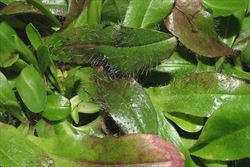
close-up of leaves, which can be hairy or almost hairless (Photo: Sheldon Navie)
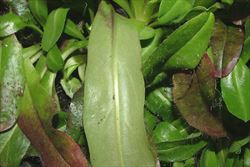
close-up of the paler leaf undersides (Photo: Sheldon Navie)
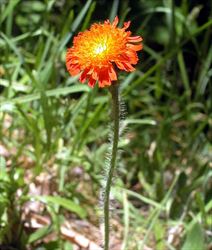
hairy flower stem and flower-head (Photo: Greg Jordan)
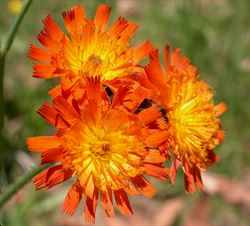
cluster of flower-heads (Photo: Greg Jordan)
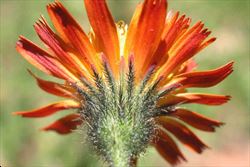
close-up of underside of flower-head showing black hairs on its floral bracts (Photo: Greg Jordan)
Scientific Name
Hieracium aurantiacum L.
Synonyms
Hieracium aurantiacum L. subsp. carpathicola Nägeli & PeterPilosella aurantiaca (L.) F.W. Schultz & Sch. Bip.
Family
Asteraceae (Queensland, New South Wales, the ACT, Victoria, Tasmania, Western Australia and the Northern Territory)Compositae (South Australia)
Common Names
devil's paintbrush, devil's-paintbrush, fox and cubs, grim-the-collier, hawkweed, king devil, missionary weed, missionary-weed, orange hawkweed, orange paintbrush, red daisy, tawny hawkweed
Origin
Native to Europe (i.e. Finland, Norway, Sweden, Austria, Czechoslovakia, Germany, Poland, Switzerland, France, Italy, Bulgaria, Romania, Yugoslavia and western Ukraine).
Cultivation
Orange hawkweed (Hieracium aurantiacum) has been cultivated as a garden ornamental in the temperate regions of Australia.
Naturalised Distribution
Orange hawkweed (Hieracium aurantiacum) is not yet widely naturalised in Australia, and currently has a scattered distribution in the cooler parts of south-eastern Australia. It is most common in Tasmania, but is also naturalised in some parts of Victoria and on the southern tablelands of New South Wales.
Naturalised overseas in the USA (including Alaska), Canada and New Zealand.
Habitat
A weed of cooler temperate and alpine environments, this species grows in pastures, grasslands, open woodlands, roadsides, disturbed sites, waste areas, gardens, lawns and alpine meadows.
Habit
A small, long-lived (i.e. perennial), herbaceous plant. It forms rosettes of leaves on the ground surface (i.e. basal rosettes) and upright (i.e. erect) flowering stems up to 40 cm tall.
Distinguishing Features
- a small long-lived herbaceous plant forming rosettes of leaves on the ground.
- its spreads via creeping aboveground stems and also produces upright flowering stems (up to 40 cm tall).
- its stalkless leaves are elongated or club-shaped and have entire or slightly toothed margins.
- its flower-heads are borne in small dense clusters at the top of the stems.
- these flower-heads (15-50 mm across) are bright orange or reddish-orange in colour.
Stems and Leaves
This species produces numerous aboveground creeping stems (i.e. stolons) that root at the joints. New rosettes of leaves develop along these stems, giving rise to new plants. It also produces upright (i.e. erect) flowering stems that are densely covered in long hairs (i.e. pubescent). Both types of stems are mostly leafless, and the stems and leaves usually contain a milky sap (i.e. latex).
The leaves are somewhat elongated (i.e. lanceolate) in shape (up to 15 cm long and 2.5 cm wide) and are almost entirely arranged in a basal rosette. They are stalkless (i.e. sessile) and have entire or slightly toothed (i.e. crenulate) margins. Both leaf surfaces are loosely covered with stiff long hairs.
Flowers and Fruit
The flower-heads (i.e. capitula) are borne in small dense clusters (5-30) at the top of the upright (i.e. erect) flowering stems. These small flower-heads (10-20 mm across) have many 'petals' (i.e. ray florets) which are bright orange or reddish-orange in colour. At the base of these flower-heads are numerous green bracts up to 10 mm long. These bracts (i.e. involucral bracts) that are covered in long blackish-coloured hairs. Flowering occurs mostly during summer and early autumn (i.e. from December to March).
The small 'seeds' (i.e. achenes) are cylindrical in shape and are ribbed lengthwise. These dark brown or purplish black 'seeds' (about 2 mm long and 0.5 mm wide) are topped with a ring (i.e. pappus) of whitish or brownish hairs (up to 6mm long).
Reproduction and Dispersal
Orange hawkweed (Hieracium aurantiacum) reproduces by seed and also vegetatively via its numerous creeping aboveground stems (i.e. stolons).
The light seeds may be dispersed by wind and water, and on animals, clothing and machinery. The creeping stems (i.e. stolons) enable colonies to spread laterally, while seeds and stem segments may also be spread in dumped garden waste.
Environmental Impact
Orange hawkweed (Hieracium aurantiacum) is as an emerging environmental weed in Tasmania, Victoria and New South Wales. It is regarded also a potential environmental weed or "sleeper weed" in other parts of southern Australia and is one of 28 species that appear on the National Environmental Weed Alert List.
This species is a potentially serious threat to native vegetation in the alpine regions and temperate tableland areas of eastern Australia. Orange hawkweed (Hieracium aurantiacum) is of particular concern in tussock grasslands in alpine areas, where it occupies the space between existing tussocks that are necessary for the regeneration and survival of native species. Its extensive creeping stems (i.e. stolons) spread along the surface of the ground and create a dense mat of rosettes that practically eliminates other vegetation. It may eventually out-compete and displace the grasses themselves causing changes to the local ecosystem. Orange hawkweed (Hieracium aurantiacum) has also spread into open woodlands in Tasmania and Victoria.
In Tasmania it has been recorded in the Southern Midlands, the Central Highlands and around Hobart. It is currently thought to infest less than 100 hectares in 10 sites in Tasmania. In Victoria it has become naturalised around Falls Creek, Mt Hotham and Mt Buller, while in New South Wales it was recently recorded in snow gum woodland on the Toolong Range in Kosciuszko National Park.
Overseas, orange hawkweed (Hieracium aurantiacum) is a major weed of natural areas and pastures in montane and sub-alpine regions in New Zealand. It also invades meadows, grasslands, rangelands, pastures, and the borders of forests in the upland areas of the USA, Canada and Aalaska. It is reported to form dense mat of vegetation in these areas which lowers biodiversity and reduces the forage value of grasslands for native grazing animals.
Other Impacts
Orange hawkweed (Hieracium aurantiacum) has the capacity to replace useful pasture grasses and reduce the overall feed value and productivity of grazing areas.
Legislation
This species is declared under legislation in the following states and territories:
- New South Wales: Class 1- a state prohibited weed. The presence of the weed on land must be notified to the local control authority and the weed must be fully and continuously suppressed and destroyed (throughout the entire state). This declaration applies to all hawkweed species (i.e. Hieracium spp.).
- Tasmania: D - the importation or sale of this species is prohibited and measures to reduce its population in an area, eradicate it from an area, or restrict it to a particular area may be required. This declaration applies to all hawkweed species (i.e. Hieracium spp.).
- Victoria: S - prohibited and is to be eradicated from the state if possible. This declaration applies to all hawkweed species (i.e. Hieracium spp.).
- Western Australia: Prohibited - on the prohibited species list and not permitted entry into the state.
Management
For information on the management of this species see the following resources:
- the Victorian Department of Primary Industries Landcare Note on hawkweeds (Hieracium spp.), which is available online at http://www.dpi.vic.gov.au.
Similar Species
Orange hawkweed (Hieracium aurantiacum) is very similar to wall hawkweed (Hieracium murorum), mouse-ear hawkweed (Hieracium pilosella) and king devil hawkweed (Hieracium praealtum ). These species can be distinguished by the following differences:
- orange hawkweed (Hieracium aurantiacum) has orange or reddish-orange flower-heads (about 15 mm across) with numerous blackish-coloured hairs on the bracts at their base (i.e. involucral bracts). Several to many (5-30) of these flower-heads are borne in dense clusters at the top of the stems. The rosette leaves are somewhat elongated (i.e. lanceolate) and sparsely covered in short hairs.
- king devil hawkweed (Hieracium praealtum) has bright yellow flower-heads (about 20 mm across) with blackish-coloured hairs on the bracts at their base (i.e. involucral bracts). Few to many (up to 25) of these flower-heads are borne in relatively tight clusters at the top of the stems. The rosette leaves are lance-shaped (i.e. lanceolate) and covered in long blackish-coloured hairs.
- wall hawkweed (Hieracium murorum) has bright yellow flower-heads (20-50 mm across) with some blackish-coloured hairs on the bracts at their base (i.e. involucral bracts). Few to many (normally 4 or 5 but as many as 20) of these flower-heads are borne in relatively loose clusters at the top of the stems. The rosette leaves are oval (i.e. elliptic) or spoon-shaped (i.e. spathulate) and usually sparsely hairy.
- mouse-ear hawkweed (Hieracium pilosella) has pale yellow or lemon flower-heads (20-30 mm across) with whitish-coloured hairs on the bracts at their base (i.e. involucral bracts). A single (i.e. solitary) flower-head is borne at the top of each of the short stems. The rosette leaves are oval (i.e. elliptic) or spoon-shaped (i.e. spathulate) and covered in long hairs.
The hawkweeds (Hieracium spp.) can generally be distinguished from other similar native and introduced species by their creeping aboveground stems (i.e. stolons) and the dense mat of rosettes that they produce. The native species Launaea sarmentosa, a plant of coastal environs, also has this habit but its leaves are hairless (i.e. glabrous). This and other similar species (e.g. Hypochoeris radicata spp., Taraxacum spp., Crepis spp., etc.) also have yellow flower-heads, while orange hawkweed (Hieracium aurantiacum) has bright reddish-orange coloured flower-heads.

